When arranging a nursery for our long-awaited baby, most of us either put off buying toys until the last minute, leaving them to friends to buy, or, on the contrary, buy up the entire assortment at our disposal. Meanwhile, toys for a baby, especially in the first months, are one of the most important sources of obtaining new information about the world, a tool for the development of consciousness and fine motor skills, which is directly related to the development of the baby’s speech. That is why we have created a short guide for you with information about what toys your child will need in the first six months of his life.
General rules when buying toys
Check the strength of the toy and make sure that it does not have small parts that could fall off and get into the baby’s mouth, or sharp edges that could cause injury. The best option is toys in red, yellow, green and blue colors. It is them that babies perceive first. Remember that the child should be surrounded by no more than 2-3 toys at a time, which you will change every few days.
Remember that the child should be surrounded by no more than 2-3 toys at the same time.
First month
In the first month of your baby's life, you won't need toys yet. But you can stimulate your baby's vision development by hanging a few near the crib or changing table. simple black and white images with geometric patterns. With their help, he will learn the ability to focus his gaze.
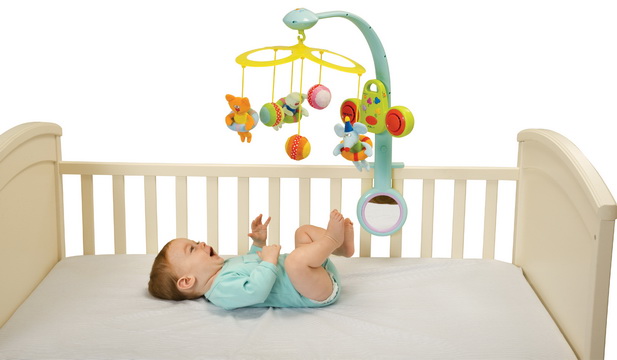
Second month
At this point, your baby will begin to be interested in his immediate surroundings, so it’s time to secure it above his crib or changing table bright mobile(movable structure with music and various figures), a funny rattle or cardboard figures(cubes, prisms, balls) with black and white geometric patterns. They will contribute to the development of the baby's vision and his ability to fix his gaze on a moving object.
Third month
Now is the time to start developing your baby's grasping abilities. Perfect for this purpose rattles and any other toys that can be taken by hand ( balls, mushrooms, plastic and rubber rings and so on). Make sure that you have rattles of different shapes at your disposal: with a grooved handle, in the shape of a ring, with a stick-shaped handle, and so on. Such toys can be either plastic or fabric. It's better if you have both at your disposal. Another necessary element of the nursery is educational mat with arcs. In addition, you will need a large beach or gymnastic ball, on which you can ride your child in the morning.
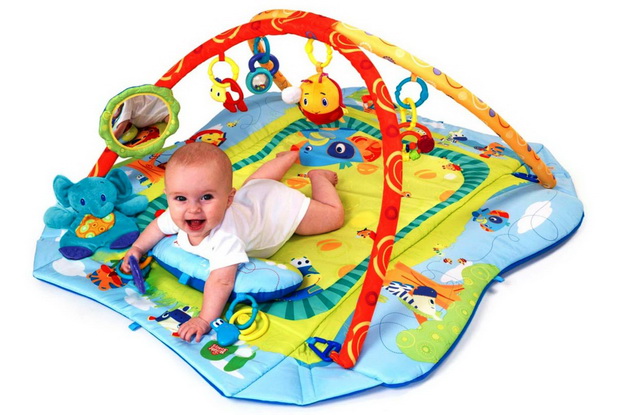
Fourth month
You will need several bright toys that can attract his attention.
At this stage, your task is to strengthen the baby’s interest in lying on his tummy and stimulate his desire to roll over. Therefore, you will need several bright toys that can attract his attention. You can use it for this purpose tumblers, rattles and soft balls, bells or other sounding toys. In addition, now is the time to develop tactile sensitivity. They will cope with this task perfectly toys made from different fabrics, or just set of different shreds(feathers, satin, fur, flannel and other materials). To develop fine motor skills, purchase bright rag bracelets or socks with a bell, which can be put on the baby's hand. This toy will teach the child to connect two handles together and touch one handle to the other. A month later you will attach them to your baby's legs.
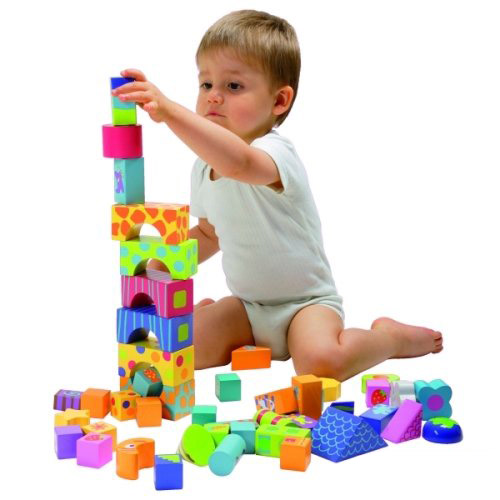
Fifth month
This month's toy is cubes. They can be either plastic, wood or even vinyl. Getting to know their rectangular shape will develop your baby's grasping skills. To develop fine motor skills at this age, stock up on small balls(about the size of a ping pong ball) , sticks and small cubes. It is better if all items are wooden. With their help, you will teach your child to transfer objects from hand to hand and make decisions. Another useful toy at this stage is a ring- teether, intended for chewing during the period of teething. Give preference to products with surfaces of varying degrees of ribbing and those that can be cooled in the refrigerator. In this case, they will help relieve pain when the first teeth appear.
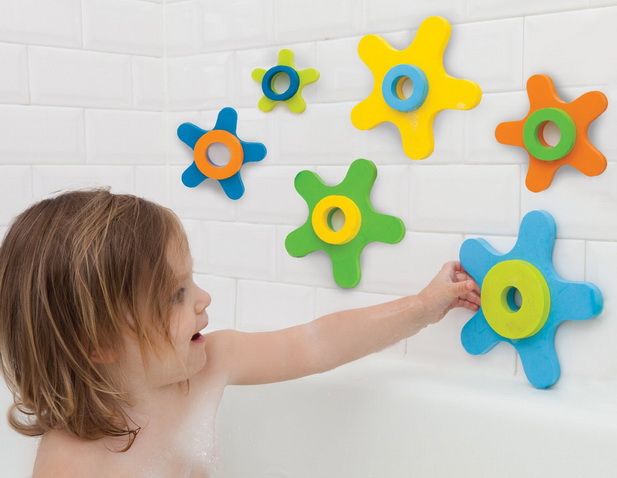
Sixth month
At this age, the child becomes interested in playing with picture books.
It's time to pay attention to the development of your baby's hearing, diversifying his life musical toys. They will teach the child to find the source of the sound, and can also stimulate his desire to crawl towards it. In addition, purchase bath toys. Your baby will have fun playing with them in the bath. At this age, the child becomes interested in playing picture books. They can be wooden, thick cardboard, rag or even vinyl. In addition to this, also purchase toys that contain mirror, the child will study his reflection with interest.
In the next article we will tell you about what toys your baby will need in the second half of the year.
Even before the baby is born, the first toys begin to appear in his room, and a year later the army of bears, hares, dolls, telephones, cars and other good things sometimes simply has nowhere to go! To prevent this from happening, we recommend that from the first days you buy your child not throwaway fun, but high-quality and useful toys, which will keep the baby busy for a long time and will bring maximum benefit to his development.
Criteria for choosing good educational toys for children under 1 year of age
An educational toy for babies under 1 year old should:
- appropriate for age. There is an age marking on each product;
- develop one or more skills and abilities relevant for children at this age. For example, crawling, speech, ability to distinguish sounds, sensory perception, etc.:
- be very durable, do not contain small parts that can be bitten off and swallowed;
- have rounded outlines without sharp corners;
- consist only of high-quality materials (plastic, fabric, latex, wood);
- sound pleasant, not harsh and not loud;
- withstand numerous cleanings and washes.
The best manufacturers of educational toys for children under 1 year old
The market for toys for children is so diverse that the child’s relatives are happy to spend money on more and more new portions of children’s fun. However, not all toys are pleased with their durability and developmental capabilities. In order not to make a mistake in choosing, pay attention to the products of world-famous brands: Tiny Love, Taf Toys, Bright Stars, Chicco, Fischer Price, Klddieland, Playskool, Playgro, etc. These products are distinguished by their impeccable quality, great developmental potential and attractive appearance.
Somewhat cheaper are toys from Chinese brands Canpol Babies, Smoby, Jetem, Rich Toys, Happy Baby, Lider Kids and others. Their quality is less stable (there are unsuccessful toys and even defective ones), but in general it is acceptable, and the price is affordable. But what you definitely shouldn’t do is choose cheap products from little-known brands for your little one. A low-quality toy is a direct threat to the baby’s health.
The best educational toys for children under one year old
“Price Expert” has selected high-quality and popular toys for the development of babies under one year of age. In this article we will not give ratings or highlight favorites, because each of the selected toys is good in its own way and is a must-have for your baby.
1. A rattle is a child’s first educational toy.
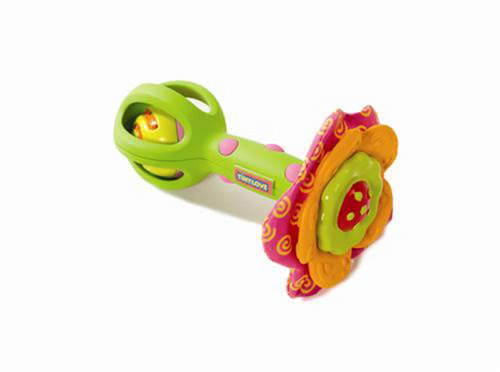
Photo: www.pilchitas.com.ar
Educational rattle toy “Flower” Tiny Love. Average price: 420 rub.
It is with these simple toys that the child’s passive acquaintance with surrounding objects begins. You can look at the rattle, find it by sound, and later feel it and even chew it. Perhaps the best developmental rattles are those that cover the development of several senses at once: vision, hearing, touch. Particularly interesting are combined options with moving parts, fabric elements, built-in rodents, etc.
Pros:
- affordable price;
- ease of use and ample opportunities for development.
Cons:
- constant and especially thorough washing of rattles is necessary;
- you have to change them often so that the baby doesn’t get tired of them.
Expert advice:« Encourage your child to grab objects, and then slowly take them away from him, gently pulling them out of his hands. It is important that the baby grasps such an object properly. If he likes this game, give your child a stick and teach him to hang from it. Then teach your baby to take and give an object (from the book by Cecile Lupan. Believe in your child)".
2. Mobile is a popular educational toy for a child up to 3 months old.
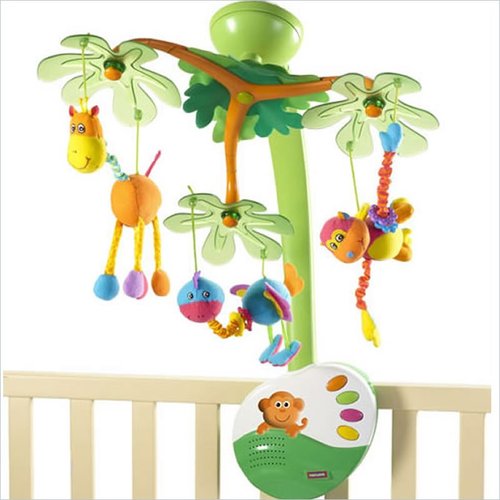
Photo: www.lussobaby.ca
Mobile Tiny Love “Island of Sweet Dreams”. Average price: 4700 rub.
Mobiles - pendants for the crib with small bright toys. Manufacturers often provide them with functions of rotation, playing melodies and backlighting. Bright moving figures and melodic sounds attract the baby's attention and calm him down, allowing the mother to move away from the crib at least for a while. This educational toy is included in the list of the best for little ones - after 3 months (sometimes earlier) the classic mobile ceases to interest the child.
Pros:
- automatic operation of the mobile frees up mother’s hands;
- beautiful toys, pleasant melodies;
- develops the child's visual and auditory perception.
Cons:
- a high-quality mobile phone is not cheap;
- short period of use;
- the child gets bored quickly;
- does not replace live communication with parents.
3. An educational mat with arcs is the best educational toy for children from 3 to 6 months.
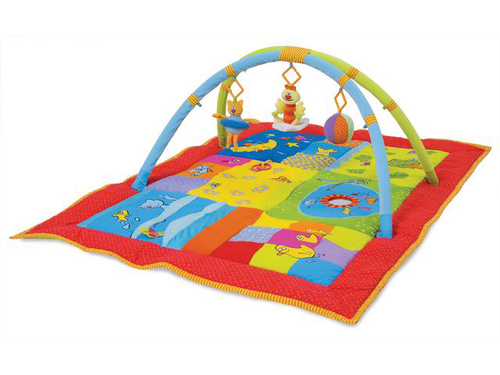
Photo: kati-shop.ru
Developmental mat TAF TOYS 2 in 1. Average price: 3600 rub.
Soft multi-colored rugs are positioned by manufacturers as “all-in-one” for the development of a baby who has not yet crawled, but no longer wants to lie still in the crib. Indeed, unlike a mobile device designed only for contemplation and listening to music, a rug with arcs opens up more opportunities for the baby’s development. Here you can not only look at toys, but also grab them, pull them towards you, taste them, feel different textures, and evoke sounds. Some rugs have areas with noise and sensory effects - for those who like to play while sitting or lying on their tummy.
Pros:
- many opportunities for the development of visual, tactile and auditory perception;
- stimulating the child’s activity and independence;
- beautiful appearance, great gift newborn;
- compact storage.
Cons:
- as soon as the baby crawls, he will no longer need the mat;
- high price.
Expert opinions: «
If your baby has already thoroughly explored the capabilities of his developmental mat, try to “extend the life” of this toy by adding new devices for tummy time:
Make small “doors” from pieces of fabric. Having opened them, the baby will see a picture, a sewn toy or a button. The “doors” can be closed with different fasteners - Velcro, hooks. Attach small toys to the ends of the ribbons and sew these ribbons inside the pockets. Now these toys can be taken out of your pockets and put back as often as you like. Sew several carpet rings in a row, pass a ribbon through them, at the ends of which two small toys will ride back and forth (from Lena Danilova’s book “Encyclopedia of Educational Games”).”
4. Soft cubes are the best toy for developing spatial thinking in children under 1 year old.
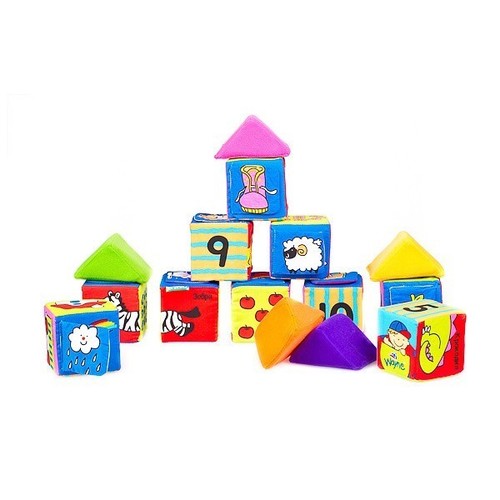
Photo: kidstore.ru
Soft cubes in a boxK'sKids. Average price 1500 rub.
Soft cubes for little ones, or “crumbs,” are an excellent alternative to wood and plastic cubes. They are large, bright, you can throw them, you can sit on them, jump and fall on them without fear. With them it is convenient to study animals, objects and first colors. Soft cubes with Velcro are especially interesting: they allow you to develop not only motor skills, but also the creative skills of the baby.
Pros:
- completely safe for the child and others;
- soft surface trains sensory skills;
- develop spatial thinking;
- useful for fine motor skills.
Cons:
- not very suitable for “serious” construction, because structures made from them are unstable;
- get dirty quickly.
Expert opinions: “Building brick sets develop eye-hand coordination and cognitive abilities. Teach your child to place cube on cube. Build a high tower before his eyes, and then destroy it, exclaiming: “Bang!” This game will give your child great pleasure. Teach him to build and destroy (from the book by Olesya Zhukova “Encyclopedia of educational games from 0 months to 3 years”).”
5. Game center - the best multifunctional educational toy for babies under 1 year old
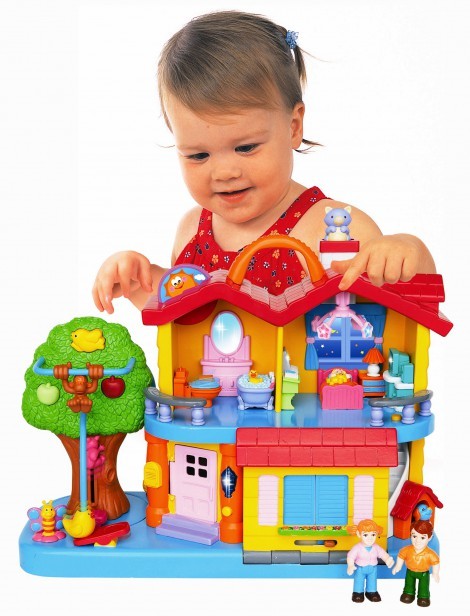
Photo: studiobajkolandia.strefa.pl
PlayhouseKiddieland. Average price: 4200 rub.
A wonderful purchase (and gift idea) for a baby who is already sitting independently. As a rule, such centers are equipped with sound capabilities, have bright colors, sound and many other pleasant discoveries for the baby (buttons, moving figures, upside-down pictures, etc.). The baby can play this game for a long time, allowing the mother to relax and calmly do household chores.
Pros:
- develop several skills simultaneously: visual, sensory, auditory, motor.
- stimulate independent play;
- occupy the baby in one place for a long time.
Cons:
- often high price;
- need to change batteries.
Expert advice: « The child loves to throw toys out of the crib and watch them fall to the floor and knock. If you are tired of constantly throwing things back, you can tie them with ribbons to the crib, the baby will very quickly figure out how to drag them back in order to throw them on the floor again (from the book by M. Andreeva “ Home psychologist. 100 secrets of raising children").
6. Children's piano is the best musical educational toy for children under 1 year of age and older.
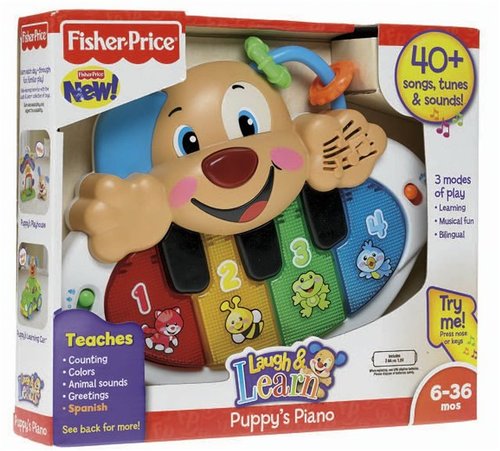
Photo: i024.radikal.ru
Fisher Price Puppy Piano Educational Toy. Average price: 1600 rub.
Small size and weight, large bright details, large keys with easy pressing, melodic songs - these are the criteria for choosing a piano for the little ones. And if the manufacturer has taken care of several volume levels (so that the baby is not afraid of loud sounds), several modes of play and learning, and an interesting, original repertoire, you can safely buy such a toy for your baby.
Pros:
- beautiful and safe toy;
- develops auditory perception and ear for music;
- helps you easily learn children's songs;
- doesn’t get boring for a long time, can be used in story games.
Cons:
- fun, but noisy;
- Batteries need to be changed periodically.
Expert opinions:“Place the musical toy out of your baby’s sight. Wind it up and ask: “Where is the music?” When the baby turns toward the sound, be sure to praise him without skimping on compliments. Repeat the game by placing the toy in different parts of the room. If your baby is already crawling, hide the toy under the pillow or any other accessible place so that he can crawl to it (from Jackie Silberg's book "125 educational games for children under 1 year old").
7. Pyramid “Cup” - an indispensable educational toy for children from 6 months
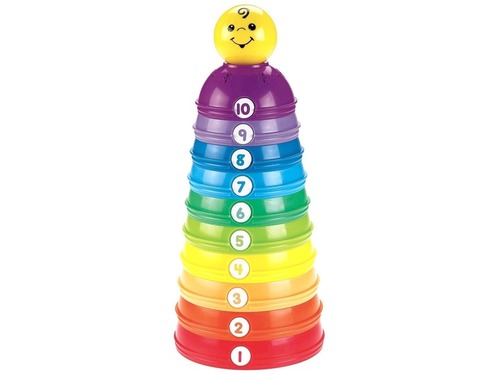
Photo: www.deshevle-net.com.ua
Pyramid “Developmental cups”FischerPrice. Average price: 900 rub.
Cups are an example of an inexpensive and incredibly functional educational toy for children from 6 months to 1 year. What makes it different from an ordinary pyramid is its complete safety: there are no small parts, no sharp pins for rings, and no chance of anything breaking. The cups can be stacked on top of each other, stacked one inside the other, or used as containers in a bath or sandbox. Dexterity of little fingers, eye, ability to compare similar objects - these are the main skills that this simple pyramid develops. In the future it will be convenient to study colors and counting with her.
Pros:
- safety;
- affordable price;
- long service life;
- functionality, different ways use for games and learning.
Minus: You can’t lose a single glass, otherwise you won’t be able to build a pyramid.
Expert advice:"Teach your baby to independent games. Independence in the game develops imagination. But first you must show your baby how to handle the toy. If the toy is collapsible (for example, a pyramid), disassemble and assemble it so that the child can see it. And then let him play himself (from the book by S. Zaitsev “A Handbook for a Young Mother”).”
8. A gurney is the best educational toy for the physical development of a child under 1 year old.
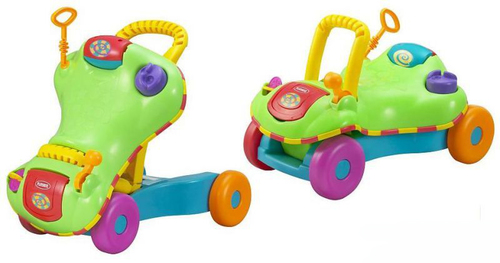
Photo: nsk-cat.ru
Roller-walker 2 in 1Playskoool. Average price: 2300 rub.
A rolling walker is one of the best educational toys for a baby’s first independent steps. According to doctors, it is more preferable for a child than classic walkers. Yes, it will not add peace to the mother, because now her child will be able to move around the house much faster. But a high-quality, stable gurney trains muscles, teaches the child to maintain balance and allows him to move on to walking independently more easily and harmoniously.
Pros:
- Great training for motor skills and gross motor skills;
- can be used at home and outdoors;
- gaming elements on the body provide additional entertainment.
Cons:
- perhaps the baby will fall more often;
- some models glide on parquet and laminate.
Expert advice:“If a child expresses a desire to walk, you should stop using the stroller unless it is necessary. This period is quite difficult, since it turns out that helping a child walk is not so easy. The best time to do this is during the day. First walk 50 meters, then gradually increase the distance. You must act lively and confident at all times. This should give courage to the baby (from the book “Believe in your child” by Cecile Lupan).”
6. Sorter is a good toy that develops the logic of children under one year old
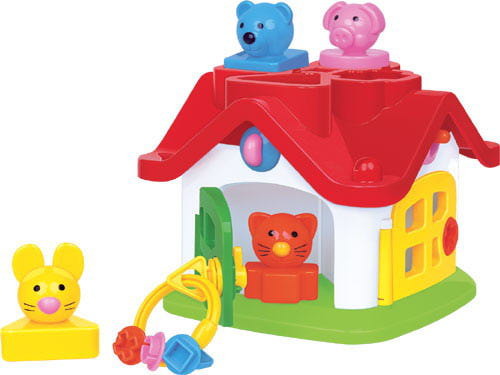
Photo: irecommend.ru.q5.r-99.com
Sorter “Logical Teremok” Polesie. Average price: 800 rub.
Sorters can be various shapes, from a simple box to a house, a car, a train, etc. Their main feature is the presence of slots of various shapes and corresponding figures. By matching a figurine to a slot, kids learn to compare objects by shape, find common features and differences in them. At the same time, fine motor skills of the hands and, of course, perseverance are trained. Sorter is not an easy game, so at first the child needs help from an adult.
Pros:
- As a rule, sorters are bright and safe toys;
- development logical thinking and finger motor skills;
- The figures can be used in teaching and story games.
Minus: figures are easily lost.
10. Pegs and hammer are a useful educational toy for developing fine motor skills in children aged 1 year.
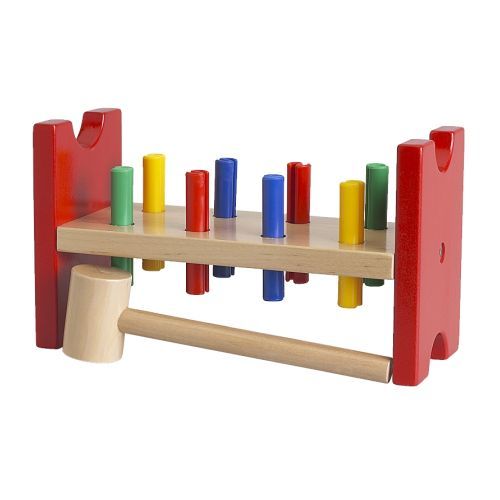
Photo: www.ikea.com
IKEA MULA Pegs and Hammer Set. Average price: 369 rub.
It is still difficult for babies aged 1 year to perform small actions with their hands. It is for training fine motor skills of the hands that all kinds of knockers, consisting of wooden base, pegs and hammer. In order to hammer a peg, a child requires coordination of movements and considerable, by child standards, effort. But even randomly knocking on pegs with a hammer is not just fun, but a useful developmental activity.
Pros:
- develops fine motor skills, and therefore speech;
- wood is an environmentally friendly, natural and durable material;
- Each peg is painted in its own color, you can study the colors;
- will be useful even after 1 year.
Minus: a child and a hammer are an unsafe duo (keep an eye on your child while playing!)
Expert opinions:“Children really like to hold various objects in their hands and hit them on a surface. Such activities perfectly develop coordination and, in addition, bring a lot of fun. Give your child a wooden spoon and show him how to bang it on the floor. Sing your favorite songs as you pound the spoons together. (From Jackie Silberg’s book “125 educational games for children under 1 year old”).”
So what educational toys should you choose for a child under 1 year old?
Of course, the baby should have a lot of games and fun, good and different, but it is always better to buy one good educational toy than two bad ones. By giving preference to high-quality, “long-lasting” options with wide gaming and learning opportunities, parents contribute to the successful development, well-being and health of their baby.
Just a few years ago, toys for children under one year old were represented by the same type of rattles, plastic balls and rubber bath ducks. Today, the range of products pleases with its diversity, which allows you to engage in the development of the baby in several directions at once. On the other hand, such an abundance of proposals can confuse any parent.
What does a child really need, and what innovation is just a marketing ploy? Are musical products so important at such an early age? Is it too early to buy educational toys for your baby? To get answers to all of the above questions, you need to familiarize yourself with the proposals and understand how they can benefit the baby.
Requirements for material and product safety
Parents usually trust the accompanying information on products that children's stores are filled with. If the cars or pyramids are marked “0+”, they can easily buy them for their kids. In some cases this ends badly. Children chew toxic paint from the surface of products or swallow small parts. When choosing toys for babies, you should not trust anyone; it is better to adhere to the following recommendations:
- Plastic should not emit a sharp or pronounced odor. After purchase, all plastic toys must be washed in soapy water and rinsed thoroughly. If even after such manipulations the specific smell of the item remains, there is a risk that a toxic product was used in production; it is better to avoid using it.
- Rubber inserts and parts should not fall off, wear out, or crumble. Babies need rubber balls from the first months of life, but it is better if they are solid, then the baby will definitely not bite or tear them.
- Products with scratches and chips are immediately discarded, no matter what purpose the toy serves. The presence of any defects indicates low quality of the product, i.e. potential risk for babies.
- We inspect fabric elements or objects down to each seam. The material must not crumble or have threads sticking out of it. Even such minor flaws can lead to the baby choking on lint or being cut by fibers.
- It is better not to use children's toys with fillers in the first year at all. If such a thing still interests the parents or the baby, you need to make sure that the little one cannot get to the filler and stuff it into his mouth.
- Sometimes it is enough to rub a toy you like a little to evaluate its quality. At a minimum, the surface should not stain your hands, not fade, or leave a greasy feeling on the skin.
- We make sure to check which toys have certificates and documentary evidence of the composition of the material. We especially carefully check cars, construction sets, modules and other items consisting of many parts.
![]()
When choosing toys for very young children, you should give preference to products made from safe food-grade plastic. In this case, the baby will be able to pull them into his mouth without risk to his health. Rubber and fabric elements must also be present in the range of items available to a child under the age of one year (so that he can get acquainted with new textures), but it is still better to additionally control the baby’s contact with them.
Must-have toys for newborns up to 3 months
The most pleasant and useful entertainment for children in the first three months of life is the contemplation of their mother’s and father’s faces and direct communication with their parents. And ordinary household items, such as napkins, washcloths, and towels stimulate the development of sensory perception in babies. But, despite the fact that these products do a good job of stimulating the development of a newborn, additional toys are still needed. It is best to please your child with the following devices:
- Mobile. A device with various figures that is hung above the crib. Today you can increasingly find musical versions of devices. The main thing here is not to make a mistake with the music. It shouldn't be too harsh or loud. It’s good if the figures depict something existing, for example, fish or flowers. Removable blocks that can be changed are welcome.

- Pendants for a stroller or crib. One of the main entertainments for young children. At first they just look at them, then they begin to reach for them, put them in their mouths, try to break them, or study them in some other way. Here you need to give preference to models with elements of different textures, shapes and functions.

Tip: Don’t try to save money on different garlands by hanging the same product from the crib to the stroller and back. A baby should have variety in this regard. It’s good if the products differ in color, shape, even musical accompaniment.
- Balls. You should not limit yourself to classic rubber or inflatable balls, which children can only look at; it is better to give preference to functional products. It is worth purchasing small, dense, smooth or rough balls, with which you can massage the baby’s palms, arms and legs. Children really love balls with different fillings, which make unusual sounds when they roll.

- Rattles. You need at least 3-4 of them. In general, these are the first educational toys for children under one year old. They allow the baby to activate vision, hearing, tactile sensations, and engage fine motor skills of the hands.

- Tumbler. Despite the fact that by the age of three months, children have not yet developed an interest in role-playing games, they all watch the tumblers with great interest. For very tiny babies, it is better to choose products that do not make too loud sounds.

All of the listed toys must be designed in such a way that there is not the slightest chance of a small part being separated. It is necessary that in small hands they remain a single, monolithic product, otherwise the baby may swallow the element.
Useful toys for children from 3 months to six months
During this period, you need to pay increased attention to what toys are purchased for the child. Now he needs developmental items that stimulate the development of sensory organs and fine motor skills. At the same time, we do not give up everything that the baby is already accustomed to. If you remove the boring module for a couple of days, the baby will have time to get bored and will enjoy it as if it were new.
- Matryoshka. For absolutely small child It is best to purchase a traditional wooden version, made in light, cheerful colors. It is better to remove the smallest figures, leaving 3-4 large ones.

- A unique and very useful invention that allows you to simultaneously entertain and develop kids. They can be simple or complex, with sound sections or “surprises”. If desired, you can even make a suitable product with your own hands; you just need to stock up on materials and fillers of different textures.

- It's time to purchase products that can diversify your baby's leisure time while he takes a bath. The modern range of offers is very wide. These can be rubber, plastic, foam objects. It would be good if they performed some additional function, for example, blowing bubbles under water.

- Cars. Even if at first the baby will only enthusiastically watch his mother ride new toy, after some time he will become interested in its design. For some time, the baby will only spin the wheels of the car, but then more daring experiments will certainly follow. To begin with, it is recommended to make do with large products consisting of a minimum number of parts, but gradually you will have to expand the “vehicle fleet”.

- Cubes. Initially, these should be lightweight structures with rounded edges in bright, but not acidic colors. In addition, babies need crumb cubes that perfectly stimulate tactile perception.

- Figurines. Not detailed, but understandable images of animals, flowers, and people will allow kids to learn to distinguish them from each other by the most obvious signs. It is recommended to reinforce classes with such products using pictures so that the child understands that the same object can look different.

Already at this age, the child needs not only to be provided with toys, but also to be dealt with personally. Considering the fact that now the baby is able to react not only to visual stimuli, it is worth connecting all the capabilities of existing products (cars roll, nesting dolls are disassembled, cubes are placed on top of each other, and much more).
The optimal set of items for the period from 6 to 9 months
The principles for choosing toys remain the same, but now you can pay attention to more complex analogues of the usual options.
- Cubes. Heavier ones, for example, made of wood, which confidently stand on top of each other, stimulate the child’s development of not only fine motor skills, but also muscle strength.

- Inserts and children's sorters. They are replacing the clumsy nesting dolls. Thanks to these products, little children can be taught to correctly estimate the size of objects, stack them, and build towers. By the age of 7-8 months, children begin to feel the urge to create something new. If you provide them with appropriate materials, in the future you will not have to worry about their coordination, memory, logic and intellectual development.

- Constructor. The simplest, consisting only of blocks or simple geometric shapes, stimulates all the baby's senses. It is quite possible that at first the baby will use the parts of the set only to knock them against each other. There is no need to try to teach him everything right away, everything will come in due time.

- Dolls and baby dolls. They should not be small; it is better to take the simplest samples, which can be used to show children what parts of the body and face a person has. According to experts, this is one of the must-have toys for children of both sexes.

But it is better to refuse such advertised interactive toys with all their buttons and levers. You shouldn’t instill in your child a love for various gadgets from early childhood. Developing fine motor skills with the help of a spinning top, bags of cereals and ropes is no less effective and does not cause any harm.
Products for infants 9-12 months
Toys are becoming more and more complex, and games are becoming more varied. By this time, the child should have developed many skills that need to be further developed and consolidated.
- Cars. Now these are more detailed products that not only roll with the help of your hands, but also make special sounds, can move with the help of a remote control or ride on their own if they are somehow accelerated.

- Pyramid. The base on which the rings are strung will perfectly entertain the baby and teach him to group elements by size, color and shape.

- Mosaic. For a small child, the floor option is ideal. It is better to pay attention to sets that do not contain many parts, but with their help you can create not just one figure, but several.

These are only the most necessary products that, despite their simplicity, will captivate the baby and contribute to his development. But they will be enough for the first year. You should not overwhelm your children with the same type or useless toys, they will only distract them from what is really important.
Not only can toys keep your little one occupied for a while, but if you choose them wisely, they can have a positive impact on his development. High-quality and correctly selected products will stimulate the baby’s fine motor skills and open up his new world and the capabilities of your own body.
The shelves of children's stores are literally littered with all sorts of goods that are designed to entertain the baby and develop his skills. Many parents, with good intentions, buy a lot of toys, which in the end their child does not play with, and they lie in boxes like dead weight.
What toys are really necessary for a baby under one year old?
We buy toys by age
For children under six months old, traditional toys are suitable, which will contribute to the development of their motor, visual and auditory skills. Since the baby spends most of his time in a horizontal position, and his hands are not yet fully controlled, the objects he deals with should not be too complex. It is enough for them to develop their sense of touch (this is achieved through the use of materials of different textures), hearing, vision and grasping skills.
In the first six months you will need:
- mobiles and toys-pendants for cribs and strollers;
- developmental mat;
- rattles;
- toys made of different textured materials;
- bells.
Babies from six months to a year require more complex toys. Their fingers are already developed enough to feel objects, and they have enough logical thinking to understand how to correctly assemble a pyramid, build a tower of cubes and put small cups into large ones. Toys during this period are designed to improve coordination, eye control and strengthen hand muscles. The baby remembers that a certain action on an object leads to some changes: hitting a drum produces a sound from it, pressing different buttons on the music panel leads to the appearance of different melodies, and a finger stained with paint leaves a colorful mark on the paper.
From six months you can buy the following toys:
- simple cubes;
- pyramid;
- a set of nesting cups;
- sets with figured slots and inserts for them;
- toys with different fillings (cereals, beans, peas);
- plasticine, finger paints;
- musical instruments (drums, xylophone, tambourine);
- game panels with music.
You can sew bags of cereals yourself, and instead of plasticine, knead salt dough.
Minimalism
It is believed that the simpler toys are for children under one year old, the better for their development. Instead of buying expensive sensory mats with brightly colored details that can overstimulate your baby, you can surround him with simple bags made from different fabrics that feel different to the touch and fill them with cereal.
Child psychologists recommend not overloading your child with too many toys. Their abundance will distract his attention and make the baby capricious and restless.
Recently, wooden toys in calm, pure colors have become popular. Parents strive to surround their child with environmentally friendly products that will not harm the baby with harmful fumes and will be pleasant to his eyes. Wooden cubes, tumblers, cars and pyramids will appeal to the baby for their simplicity.
When visiting children's stores, choose only the toys necessary for your baby. Think about what products he needs based on his age, and what skills the “best” models suggested by consultants will help him develop. Avoid buying functionally overloaded expensive gaming stations, as your baby may get bored with them quite quickly. It’s better to surround it with simple developmental elements.
Rattles
Rattles, despite their simple design, are very useful for the development of children. They teach the baby to concentrate, enhance auditory and visual perception, and also hone coordination of movements. Rattles develop the baby's grasping reflex and fine motor skills. The baby shakes the toy, it makes sounds - and this helps him build cause-and-effect relationships.
- the rattle should not be too heavy for the baby;
- if you want to buy your baby several toys, select them in such a way that they are all different shapes and colors; the same type of rattles will not arouse the baby’s interest;
- you can choose rattles for your baby from different materials(plastic, latex, wood), this will develop his sense of touch;
- it is desirable that the handles of the rattles be different to the touch, let one be smooth, the second ribbed, the third with bulges, etc.;
- Rattles that make noise in different ways will develop your baby’s hearing; choose rustling, smoothly rattling models, but avoid too loud ones that can frighten the baby;
- children under six months old like transparent models with multi-colored elements rolling inside them;
- Feel the toy before buying it for your baby - there should be no sharp corners on it that could harm the baby.
Buy only certified baby rattles and check their integrity regularly. All parts on toys for babies must be well secured. Regularly sterilize all rattles, and wipe those that fall on the floor with a gauze cloth soaked in hydrogen peroxide.
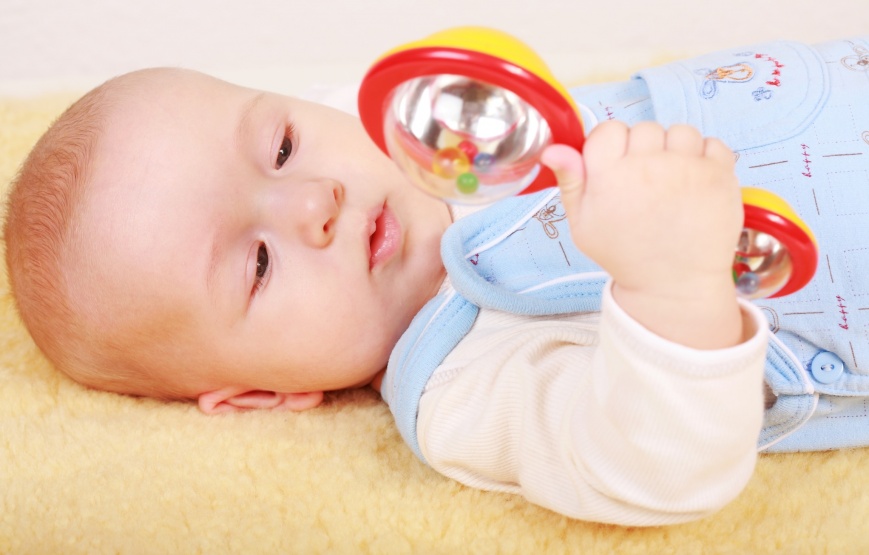
Mobiles and pendants
Mobiles and pendants are usually the first toys for babies. For a little-awake baby, the only type of activity is observation, so bright hanging or moving elements in front of his eyes will interest him and will contribute to the development of his vision and concentration. Over time, the baby will try to touch the pendants with his hands, feel them with his fingers and shake them.
Musical mobiles can not only entertain your baby for a while. Bright moving elements will develop baby's eye muscles as he follows the movement of toys. When the baby tries to grab flying elements, this will train the coordination of his movements.
- so that your baby gets a different tactile experience, use garlands and pendants made of different materials - plastic, latex, wood and textile;
- for walking and home use should be various toys;
- regularly treat wooden and plastic parts of your mobile, garlands and pendants with hydrogen peroxide, boil removable parts, and wash fabric parts with baby powder;
- hang garlands in a newborn’s stroller, crib or car seat in such a way that it can be touched by involuntary movements; the sound from the rattles will attract the baby’s attention;
- for an older baby who can consciously control his hands, the garlands can be hung a little higher so that he can reach out and grab them;
- the colors of the elements should be bright and simple, and the shapes should be varied, so it will be more interesting for the baby;
- The sounds produced by music mobiles should be quiet and melodic.
Pyramid
The pyramid can be different: simple, consisting of 3-4 rings, as well as complex and multi-level. It can have a standard cone-shaped shape, repeat the outlines of stylized animals, or be an integral part of other toys - tumblers and rollers. Rings come in textile, wood and plastic. The purpose of the pyramid in any of its manifestations remains the same - to teach the baby to think, correlate the sizes of parts and help develop his coordination.
With the help of pyramid rings, you can teach your child to recognize “big” and “small”, “wide” and “narrow”, “top” and “bottom”. Also, for many kids, this toy becomes the first visual material when learning colors.
For children under six months old, pyramids with a small number of rings are suitable, and their diameter should be significantly larger than the rod on which they should be strung - this will make it easier for the baby to learn this difficult action for him. Since the baby will constantly pull the removed rings into his mouth, you should regularly care for them: wash textile parts, and treat plastic and wooden parts with hydrogen peroxide.
Nesting toys
Insert toys are quite primitive at first glance, but are very useful for the development of infants. By working with such sets, the baby learns to analyze and coordinate his actions. The child will love both nesting multi-colored cups, from which you can also build a turret, and insert frames with small parts of different shapes.
With the help of nesting cups and parts, you can teach your child to identify colors, shapes and sizes, and in the summer you can use them to play Easter cakes.
Don’t rush to buy complex models for your child, otherwise, once you fail to complete the task, your child may begin to have a negative attitude towards the toy. Start with simple sets: cups that can be easily inserted into each other for a child with poor coordination, and small frames with simple geometric holes. You can buy a matryoshka doll for your baby, just check first whether the wooden parts of the toy fit together easily.
Cubes
Cubes are perhaps the simplest educational toys for children under one year old. Your child will need plastic or wooden products for a very long time. They will be useful to him not only for building towers, but also for studying colors, sizes, and, if there are appropriate pictures, the alphabet and numbers.
By the age of six or seven months, buy your baby the simplest painted wooden cubes and show him how to use them. Point out to him that they different colors, compare their shape with balls, try to roll them. The child will really enjoy such research, and you will see how he will begin to experiment with other toys, gaining his own experience.
By 10-11 months, you can purchase children's cubes with a simple pattern on the edges, which need to be assembled by turning the sides. With your help, your child will quickly learn to add simple pictures. Once your baby understands the principle, you can start buying wooden or plastic blocks with more complex designs. Don’t worry that too many of these toys will accumulate—the child will later need them to build towers and castles.
Dynamic toys
Children under one year old constantly explore the world; they test every object that comes into their hands, shake, crush and throw, observing how the object reacts to their actions. Dynamic toys will delight the baby and keep the little tester occupied for a long time. The baby will love that after pressing the lever, the spinning top begins to spin, the car rolls, and the tumbler, no matter how much you push it, does not want to fall.
- When choosing a dynamic toy, avoid acidic colors; the shades of the product should be in harmony.
- Some spinning top models have pictures on their body that create interesting illusions when moving.
- The sounds that dynamic toys make should not be too sharp or loud.
- Before purchasing a spinning top, make sure that the product is correctly centered, otherwise the toy will not rotate as expected and will not give your baby the pleasure it deserves.
Tactile toys
Starting from six months of age, children actively explore the objects around them using the sense of touch. Various tactile sensations stimulate nervous system infants and thus directly influence the rate of development. The more you provide your baby with objects of different textures to explore, the better this will affect his nervous system.
You can place your baby on a sensory mat made from different-feeling materials, or let him play with toys made from mixed fabrics with sewn-on beads, buttons, and ribbons. By exploring such useful and interesting toys with his fingers, the baby will enrich his tactile experience.
Some mothers sew bags for their babies and fill them with different cereals. By kneading such “homemade products” with peas, beans and millet in his hands, the child will develop fine motor skills.
After six months, you can purchase finger paints for your baby and practice drawing with him. The baby will really enjoy leaving bright marks on the paper. It is important to ensure that the paints you buy are non-toxic and child-safe.
Activities with plasticine or dough are also very useful for tactile experience and the development of fine motor skills in children under one year old. You can teach your child how to roll sausages, flatten pieces of plastic material, and connect pieces together. Of course, the baby’s crafts will be barely recognizable, but the main thing now is to develop his fingers, bringing pleasure to the baby.
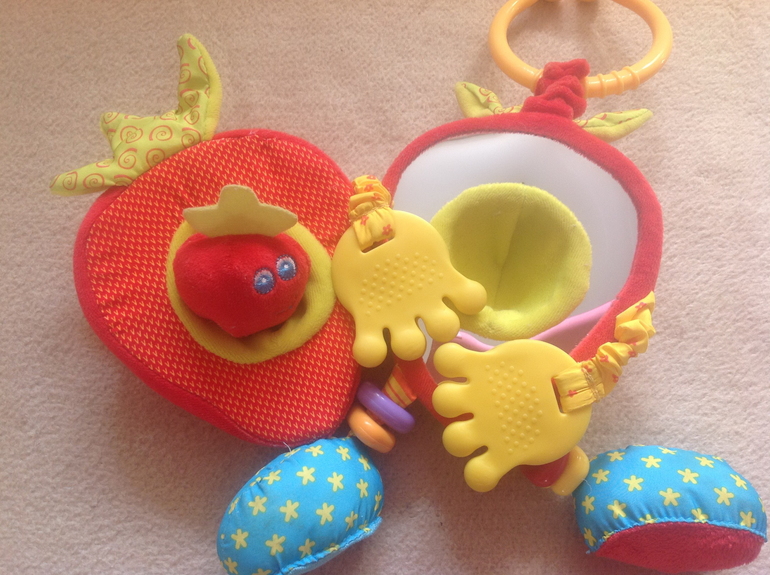
Figurative toys
Such toys, in their appearance, copy living creatures - cats, dogs, bears, children, as well as cartoon characters. Children under one year old do not yet know how to play independently. story games, but such toys are very useful for getting to know a new world, for the ability to relate images on the screen and in books with stylized objects.
With the help of plush pets, you can introduce your baby to the world of animals and teach him the sounds they make. Using dolls, you can show your baby what body parts people have, and he will associate himself with the toy. Closer to one year, the child will already copy your actions and take care of the baby doll, seat plush animals at improvised tables and feed them.
What toys should I buy for a child under one year old?
Toys for children under one year old, as well as for any other age, must meet all safety requirements. Special attention You should pay attention to the material of the toy, because babies at this age love to put everything in their mouth.
Toy for a child of the first year of life- this is not fun, but a source of new information. During the first year of life, the baby makes a colossal leap in development. He develops all types of sensitivity, coordination of movements and the initial elements of thinking.
Toddlers need toys that contribute to the development of vision, hearing, touch, hand movements, coordinated movements of the hand and eye. The toy should be comfortable for the child. But at the same time, the concept of its functional comfort is relative.
If the toys have calm color (pink or soft blue), the baby quickly gets used to them and stops noticing. In addition, the baby does not yet distinguish colors well enough to perceive such “undefined” colors as blue and pink. Toys should encourage the child to be exploratory, so that his hand reaches out to them following his gaze.
Each period of early childhood has its own toys, but in terms of their functionality they should be somewhat ahead of the child’s already achieved level of development.
Baby is one month old
At this age, toys should stimulate the child's senses; brightly and contrastingly colored rattles are especially useful.
1-3 months
 First of all, toys should contain red, yellow, orange and green colors. Already at 1-2 months of life, it is necessary to hang a garland of rattles and mobiles over the baby’s crib. The arrangement of elements on the garland, taking into account the peculiarities of the development of visual sensitivity of a newborn, should be as follows. In the middle - red, then orange, yellow, green and blue at the edge.
First of all, toys should contain red, yellow, orange and green colors. Already at 1-2 months of life, it is necessary to hang a garland of rattles and mobiles over the baby’s crib. The arrangement of elements on the garland, taking into account the peculiarities of the development of visual sensitivity of a newborn, should be as follows. In the middle - red, then orange, yellow, green and blue at the edge.
The baby begins to raise his head and look the world around us. To develop motor skills and hand coordination, provide your baby with toys with different textures that are easy to grasp. Don't forget that they should also be rustling and noisy.
Starting from the 2nd month of life, it is necessary to hang baby toys 45-50 cm from the chest. With their help, he will learn to focus his gaze. Toys should be moderately bright and with pleasant melodic music. From time to time you need to update toys, hang new ones and remove boring ones.

3-6 months
For children from 3 to 7-8 months of age, the most important are didactic toys aimed at developing the basic types of sensitivity, as well as the gradual formation of the baby’s arbitrary actions. Toys should be bright, simple in shape, and preferably such that the child himself can change something in them. It’s good if with their help the baby can make some sound.
Toys may be different by relief(for example, a plastic hedgehog is useful for developing skin sensitivity). These can be all kinds of pendants with multi-colored rings, balls, sticks, hedgehogs on cords. By changing the position of the balls, an adult can actively attract the child's attention to them.
By the middle of the first year, a child who accidentally grabs a ring on such a garland begins to manipulate it and thereby swing the balls hanging from above, which, in turn, create a clattering sound. The child sees the result of the action of his hand and repeatedly achieves the effect caused. That's it coordination of the actions of the eye, hand and ear develops. These toys are aimed at helping the child learn to control his gaze, following moving objects. And even if the baby has not yet learned to use his hands, he just likes to look at the brightly colored objects hanging above the crib.
As an option, child psychologists suggest attaching specially designed pendant beads. When the bead is moved along the cord, first by an adult, and then by the child himself, the spatial and color composition changes. It is important that small parts pass freely through larger ones, and first an adult, and then a child, can mix them. You can also use a pendant with a mirror. The child sees his reflection in the mirror, communicates with himself without even knowing that it is him, and sees other details of space.
After 5-6 months, the child likes to hold objects in his hand, rattle them, and chew them. Plastic toys (like small rings placed on a large ring) are especially good because they won't peel off the paint and won't bite through like celluloid toys.
A child strives to explore the world through his mouth, so make sure that the baby cannot swallow the toy or its parts.
If the toy makes a variety of sounds, the little one will be delighted (make sure the sound is not too loud).
The best educational toys for babies up to 6 months – these are rattles that allow the baby to plunge into an unknown world physical properties surrounding objects, which the child explores with the help of his senses.
A three-month-old baby is already more actively interested in surrounding objects. You can use a garland with an elastic band that is attached to the stroller, and attach long rattles to it, which the baby will rock and make sound from.
From the age of 4 months, the baby consciously reaches out to toys that interest him and tries to get them.
When babies roll over on their tummy on their own, it is good to place the baby on the floor on a warm blanket while he is awake and put various toys around him. Various rattles, rubber, plastic and wooden objects without sharp corners and small parts, as well as soft, lint-free toys are suitable.
6-9 months
The baby already knows how to sit and is attracted in every possible way by both jingling toys and a variety of soft balls. Stringed large beads are perfect for developing fine motor skills.
After five months, babies become very mobile, trying to crawl, sit up and explore the surrounding reality. It’s still too early for them to part with their usual rattles, but it’s time to learn new entertainment. Psychologists recommend purchasing the following toys by the age of six months:
Rattles.Choose complex rattles with unusual handles and shapes so that the child learns to grasp them in different ways and develops fine motor skills. Especially interesting for him will be the now fashionable soft rattles in the form of animals and dolls. They usually have a built-in mirror or sewn-in massage beads, which will undoubtedly delight the little one’s fingers.
Rubber squeak toys . Ideal for a bath. The child can already sit and just wash himself; he is bored. Show how a duck swims or how a rubber frog squeaks; this will not only make swimming interesting, but will also expand the child’s understanding of the world. High-quality rubber beepers are easy to press and float smoothly.
Balls, cars.For a “crawler”, it is important to have moving or rolling toys; they help the child master the first method of movement – crawling. It is better if it is a horse on wheels or a simple medium-sized car. We choose bright balls and different sizes so that you can roll and skate.
Handkerchiefs, rags . At the age of 6-7 months, the child enjoys playing hide and seek, loves to find others and hide himself. You can cover a toy or your face with a variety of rags, and ask your baby “Where is mommy?” and admire with the child: “Here she is!” Creative mothers can sew a developmental mat from a variety of fabrics that will help the baby explore different materials and sounds (rustling, tapping, rolling peas).
Books.It's time to introduce the baby to the first book. Let it be thick (after all, the child will taste it first!), with large pictures and a minimum of text. Classics – “Ryaba Chicken” and “Turnip”.
Cubes and pyramids . The child will like large colorful cubes if the mother builds a tower out of them. The baby is still not good at building on his own, but he will destroy the building with pleasure! The same goes for pyramids; the baby can’t assemble them yet, but he’s already happy to hand the rings to his mother. A pyramid is needed with a stable base and wide holes for rings, these can be...
Educational toys. The simplest sorters, balls moving along arcs, rollers for balls - all this can be found in regular stores or departments for early development. Choose the simplest “developers” with a minimum of details, large size, simple shape. Once your baby learns to insert objects into the sorter holes or roll balls, you can purchase more complex objects. Most of these toys are developed by experienced teachers, so they not only keep the baby occupied, but also stimulate quick mental and creative development
9-12 months
In this trimester toys for children up to one year old can be very diverse: balls, marbles, cars, squeakers. Excellent educational toys are a variety of pyramids, sorters, and lacing.
At this time, the child’s favorite pastime is manipulating toys. The baby happily knocks one toy on the table and another toy, listening to the sound produced, waves it, drags it into his mouth, throws it and demands to pick it up. It is very good to use household items - wooden spoons, boxes, etc. At 9-12 months, children begin to willingly put small objects into one large container.
They begin to play a special role dolls. From 10-11 months, the child can already show his eyes, nose, mouth, arms and legs. In addition, at this age the baby should have blocks, a light ball, and books with hard pages. The child will also enjoy pushing the toy on wheels across the floor. It's time to introduce the baby to educational toys - a box with holes of various shapes, where you need to put different figures, simple construction sets with large parts, collapsible nesting dolls, etc. In a word, pamper your baby with educational toys, and don’t forget to play with him.
The baby no longer only crawls, but also walks holding onto furniture and sofas. Someone walks in a walker. But the kids want to take it, touch it, everything is interesting to them. The baby needs a variety of toys: squeakers, balls, balls, cars. Toys should be both soft and hard, of different shapes, textures, and from different materials. Children should also be given handkerchiefs and rags, because they provide an opportunity for different actions baby: take cover, wrap toys. Children imitate various actions, for example, trying to put on pants.
Toys that require different actions: putting in, sticking out, building (pyramids), rotating, pressing, moving, moving.
Very exciting for one year old child may become children's houses. Children's playhouses help develop your little one's imagination, creativity. Believe me, such a house will serve him for the next few years.

Bath toys
At this age, you can already purchase bath toys, which should be very simple - plastic or rubber figures, preferably non-sinking. The first toys in the bath have educational significance: they move on the surface of the water, you can dip them, but they always come up, etc. More complex toys that perform various mechanical movements are suitable for slightly older children, but for now they will not be interesting and understandable for the child.
Educational toys for children up to one year old are designed to diversify children's tactile sensations, which ensures full sensory development. A child will develop much faster if he has as many toys as possible that “feel” different from each other. These toys include sensory mats and bags, and finger paints.
Manipulating objects also has a positive effect on early development Baby, children under one year old especially like toys with high functionality. Very popular among children after six months are sets of various containers that can be placed inside each other, interesting option A toy of this kind is a pyramid of cups.
for babies from 6 months better to give colorful toys from different materials, because From this age tactile sensitivity begins to develop. Children over 6 months of age are interested in pyramids, cubes, construction sets, and everything that moves and makes sounds. For example, a pyramid helps a baby train coordination of movements, develop fine motor skills, intelligence and attention. The cubes also contribute to the development of fine motor skills, improvement of motor coordination, voluntary attention and logical thinking. Both of these types of toys help babies learn colors.
The motto of the baby’s first three months is to watch and listen. After the first month of life, babies already perceive colors, so the most suitable toys will be both bright and contrasting, as well as calmer shades rattles, which can be hung at eye level of a child in a crib or stroller. Nowadays there are many different spinning musical toys that can also be hung in the crib. Small bells that can even be hung from a chandelier are also good. When choosing sounding toys, check how pleasant the sounds they make are and whether they are too harsh and loud.
It is known that in understanding the world around children, all senses are involved - vision, hearing, taste, touch, smell. That is why it is important for them to see, hear, touch and try everything.By 3-4 months kids begin to become interested in their arms and legs, actively move them, and examine them. You can diversify your baby's experience by using a soft-sounding rattle with Velcro, attaching it to your baby's wrist or ankle. Pushing your hands against hanging objects, the child learns to grab and feel them. And tactile sensations are very important, because this is one of the ways to understand the world.
For crawling babies , mastering the space of the apartment, will suit multifunctional toys, in which everything opens, moves, is pressed and at the same time makes different sounds. Moving toys will also be interesting. Don't forget that in household you can find many great items suitable for games. These are various pots, bowls, spoons, ladles, etc. Kids love games like this, when one object can be hidden in another, covered with a lid, and taken out again.
Water games also help the child develop. Kids are interested in pouring and pouring water from various containers. Games of “hide and seek” will also be interesting, when you hide objects and then find them together.
The ability to act with objects and manipulate them is an important step in child development. By learning to connect and separate parts, they not only learn the properties of objects, but also perfectly develop fine motor skills, which contributes to the development of speech.
A little later, when the child begins to walk, good remedy for its development there will be construction sets, prefabricated turrets, pyramids. Games with cubes are also becoming more varied. It is desirable that they be made of various materials - wood, plastic, fabric. A one-year-old baby will also benefit from simple kits for role playing games : dishes, doll furniture, animal figurines, doctor's set, cars, dolls, soft toys.
Rolling toys, that need to be pushed, for example, a butterfly on a stick or a jingling ball, will help the baby move more confidently, because they create a feeling of support. Playing ball brings great joy and positive emotions to a child. Ball games develop coordination and spatial orientation. The main thing is to play with your baby. After all, no toy will bring the benefit that your imagination, creativity and desire to play with your children can bring.
For normal growth of babies in all respects , necessary children's sensory development early age take under close parental control. Starting from the period of two to three months, mothers should take care that the baby gradually gets acquainted with objects of different sizes and textures and has the opportunity to touch and feel them.
In the first year of life, children's consciousness is most susceptible to assimilation of information about the size and shape of objects. Therefore, stock up on toys in the form of circles, cubes, pyramids, with colors pleasing to the eye, from environmentally friendly materials, dense in texture, but without sharp corners, which, on occasion, can be tasted without harm to health, since children explore this world with all accessible ways. At first, you can simply hang them on cribs.
When your child learns to sit, you can invite him to play with a toy that you can make yourself. Because characteristics of young children are such that they study objects thoroughly and from all sides, give him a box made of thick cardboard with many holes made in it.
The holes should have a diameter convenient for you and the baby, into which you can stick your fingers and study how it works from the inside. In order for the child to be interested in studying it, the insides of the box should first be covered with materials that feel different to the touch - fur, burlap, rough sandpaper, satin, and the like. The main thing is that the material is different. Explore the inside of the box together and focus your baby’s attention on the sensations he experiences when touching it. different types fabrics.
Educational toys
You also need to buy all kinds of educational balls, cubes and prisms. In addition, cubes and prisms for little ones should be safe, with slightly rounded edges. Particularly interesting can be sensory cubes made of translucent material, inside of which there are various figures, which kids look at with great pleasure. The cubes are also more functional, since they can be used later for construction. Remember, a detailed railway will be a good gift and a toy for your child, but not when the child cannot walk yet.
But sets of cups and pyramids are what you need. Such toys introduce the child to the concept of more and less. But when choosing toys of this kind, it is important to pay attention to the colors of the parts; they must correspond slightly to the colors of the rainbow, be distinguishable, contrasting and bright.
Cups are a multifunctional toy that will also last a child for a long time if made from high-quality materials. The cups can be stacked into each other or laid one on top of the other, played with them in the water or used instead of molds in the sand, even baby crib can become an arena for playing with cups; it is safe, since the child will not get hurt by them in a confined space. The cups can have patterned or smooth edges, various patterns or holes can be drawn on the bottom, especially for playing with water, in a word - a universal toy.
In general, it is worth remembering that after six months the child is just beginning to really get acquainted with the world around him and concepts, simple toys They will help him with this, but complex ones will only harm him.
Development of fine motor skills of the hands or
Some ideas on how to keep your child busy in the kitchen:
to have time to prepare everything
1. Cereals on a plate . Place two or three types of cereals on a large flat plate. The child sorts it out, touches it, compares it, and you tell where it comes from and what you can do with it (porridge, for example).
2. Cover a sheet (cardboard, plastic) with a thin layer of plasticine. Pour buckwheat, rice, peas into different plates and show your child how to lay out patterns, pressing products into plasticine. You are guaranteed 10 - 15 minutes of silence.
3. The most delicious games – pour together two or three varieties of raisins, nuts, different in shape, color and taste. And let him sort them out.
4. We take different jars and lids for them. The child must select lids for jars. It is advisable that the caps be of different sizes, then it will be easier for the child to select them. The lids can be put on or screwed on. These can be small plastic bottles, jars from baby food and others that you can find in your kitchen. By closing the lids, the child trains his fingers and improves the development of fine motor skills.
5. Pour some juice from the berries onto a plate. Give your child a few pieces of refined sugar. Let the baby take turns dips the pieces into the juice and watches how the juice gradually rises and turns the sugar a beautiful color.
6. Place two cups in front of your child. Pour cereal into one and leave the other empty. Show your child how scoop up cereal with a spoon in one cup and pour over her to another. When there is little grain left in the first cup, show how to tilt the cup to collect all the grain.
7. Give your baby ice cube trays, a dropper and water. To make it more interesting, the water can be colored with juice. Let the child draws liquid into a pipette and pours it into molds. This game is great for developing fine motor skills and concentration.
8. Place semolina or other grains on a flat dish or tray. Let the child draws with his finger along the grain, leaving various shapes. Show your child how to draw the simplest shapes: squares, diamonds, circles.
When your child copes well with this task, make it more difficult. For example, you can fill the white paths from your fingers with cereal of a different color. To do this, teach your baby the finger movement with which we salt food. This educational game has a good effect on the development of fine motor skills, imagination and imagination.
9. Give it to the baby piece of dough. He will be happy to sculpt with it, while improving the development of fine motor skills of his fingers.
10. Educational game “Making beads”. You will need pasta with a large opening and a long string. Task for the child: string the pasta onto a string.
By the way, the more the baby works with his fingers, the better the development of fine motor skills of the hands and the earlier and better his speech develops. The fact is that in the cerebral cortex, motor and speech areas are located nearby. Moreover, speech is actively formed under the influence of impulses coming from the fingers.
So it turns out that the level and pace of development of a baby’s speech directly depends on how developed the subtle movements of children’s fingers are.
Let's sum it up
Up to 8 months of age, various bell games, rattles, hanging toys (for example, mobiles, rattles), something for biting, toys that can be rocked, with buttons for pressing, pulling, twisting, are good for the baby. Rattles and toys with a bell help expand the baby’s awareness of sounds, especially when he himself makes these sounds and can “experiment.” Toys should be light, bright and, of course, larger than the child’s mouth. A baby of 9-12 months of age can already buy books with large bright pictures no small parts.
If you are interested in how to work with a child, how to develop him, how to reveal all his abilities, then I advise you to pay attention to collection of educational games “Child development. How and what to do with a child from birth to one year old" . In it you will find a huge variety of games and activities with your child for every month of the baby’s first year of life, which will contribute to his development.
These games are simple; no complex manuals or materials are required to play them. But they help make regular activities and walks with your child useful and interesting.



